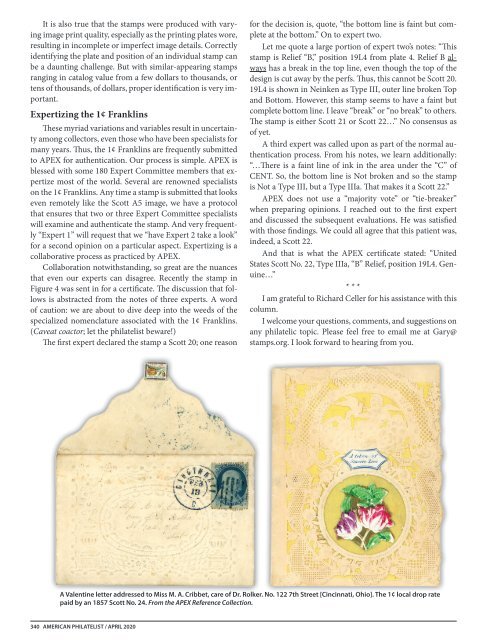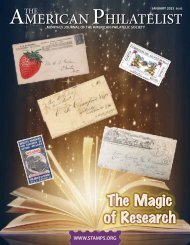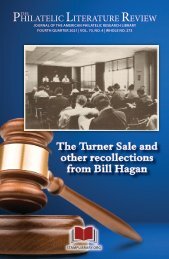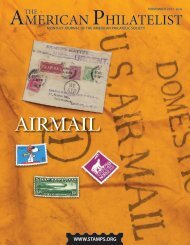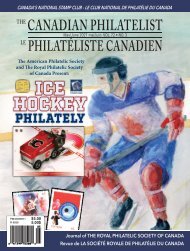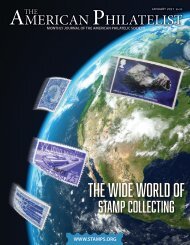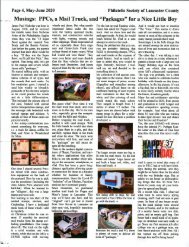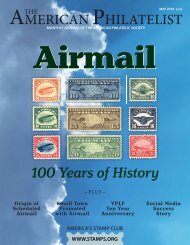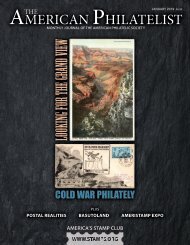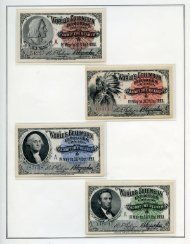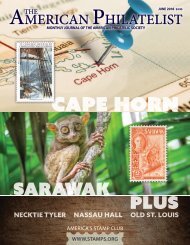The American Philatelist April 2020
Holocaust Rememberance Issue
Holocaust Rememberance Issue
You also want an ePaper? Increase the reach of your titles
YUMPU automatically turns print PDFs into web optimized ePapers that Google loves.
It is also true that the stamps were produced with varying<br />
image print quality, especially as the printing plates wore,<br />
resulting in incomplete or imperfect image details. Correctly<br />
identifying the plate and position of an individual stamp can<br />
be a daunting challenge. But with similar-appearing stamps<br />
ranging in catalog value from a few dollars to thousands, or<br />
tens of thousands, of dollars, proper identification is very important.<br />
Expertizing the 1¢ Franklins<br />
<strong>The</strong>se myriad variations and variables result in uncertainty<br />
among collectors, even those who have been specialists for<br />
many years. Thus, the 1¢ Franklins are frequently submitted<br />
to APEX for authentication. Our process is simple. APEX is<br />
blessed with some 180 Expert Committee members that expertize<br />
most of the world. Several are renowned specialists<br />
on the 1¢ Franklins. Any time a stamp is submitted that looks<br />
even remotely like the Scott A5 image, we have a protocol<br />
that ensures that two or three Expert Committee specialists<br />
will examine and authenticate the stamp. And very frequently<br />
“Expert 1” will request that we “have Expert 2 take a look”<br />
for a second opinion on a particular aspect. Expertizing is a<br />
collaborative process as practiced by APEX.<br />
Collaboration notwithstanding, so great are the nuances<br />
that even our experts can disagree. Recently the stamp in<br />
Figure 4 was sent in for a certificate. <strong>The</strong> discussion that follows<br />
is abstracted from the notes of three experts. A word<br />
of caution: we are about to dive deep into the weeds of the<br />
specialized nomenclature associated with the 1¢ Franklins.<br />
(Caveat coactor; let the philatelist beware!)<br />
<strong>The</strong> first expert declared the stamp a Scott 20; one reason<br />
for the decision is, quote, “the bottom line is faint but complete<br />
at the bottom.” On to expert two.<br />
Let me quote a large portion of expert two’s notes: “This<br />
stamp is Relief “B,” position 19L4 from plate 4. Relief B always<br />
has a break in the top line, even though the top of the<br />
design is cut away by the perfs. Thus, this cannot be Scott 20.<br />
19L4 is shown in Neinken as Type III, outer line broken Top<br />
and Bottom. However, this stamp seems to have a faint but<br />
complete bottom line. I leave “break” or “no break” to others.<br />
<strong>The</strong> stamp is either Scott 21 or Scott 22…” No consensus as<br />
of yet.<br />
A third expert was called upon as part of the normal authentication<br />
process. From his notes, we learn additionally:<br />
“…<strong>The</strong>re is a faint line of ink in the area under the “C” of<br />
CENT. So, the bottom line is Not broken and so the stamp<br />
is Not a Type III, but a Type IIIa. That makes it a Scott 22.”<br />
APEX does not use a “majority vote” or “tie-breaker”<br />
when preparing opinions. I reached out to the first expert<br />
and discussed the subsequent evaluations. He was satisfied<br />
with those findings. We could all agree that this patient was,<br />
indeed, a Scott 22.<br />
And that is what the APEX certificate stated: “United<br />
States Scott No. 22, Type IIIa, “B” Relief, position 19L4. Genuine…”<br />
* * *<br />
I am grateful to Richard Celler for his assistance with this<br />
column.<br />
I welcome your questions, comments, and suggestions on<br />
any philatelic topic. Please feel free to email me at Gary@<br />
stamps.org. I look forward to hearing from you.<br />
A Valentine letter addressed to Miss M. A. Cribbet, care of Dr. Rolker. No. 122 7th Street [Cincinnati, Ohio]. <strong>The</strong> 1¢ local drop rate<br />
paid by an 1857 Scott No. 24. From the APEX Reference Collection.<br />
340 AMERICAN PHILATELIST / APRIL <strong>2020</strong>


